So you’ve got yourself a cactus cutting and you’re ready to plant it. Planting a cactus cutting is a relatively simple process, but it does require some care and attention to ensure that your cutting thrives and grows into a healthy cactus plant. In this guide, we’ll take you through the step-by-step process of planting a cactus cutting successfully.
1. Let the Cutting Callus Over
Before planting your cactus cutting, it’s important to let the cut end callus over. This helps prevent the cutting from rotting once planted in soil. Place the cutting in a dry, warm location and allow it to callus over for a few days to a week, depending on the size of the cutting.
2. Choose the Right Soil
Cacti thrive in well-draining soil that is slightly acidic. You can use a commercial cactus mix or create your own by mixing sand, perlite, and potting soil. Make sure the soil is dry before planting the cutting to prevent excess moisture around the roots.
3. Plant the Cutting
Once the cutting has callused over, gently press the cut end into the soil. Make sure the cutting is planted at the right depth – deep enough to support it but not so deep that it becomes buried. Firm the soil around the cutting to provide stability.
4. Find the Right Location
Place the planted cutting in a location that receives bright, indirect sunlight. Avoid placing it in direct sunlight, as this can scorch the cutting. A bright shaded area is ideal for a newly planted cactus cutting.
5. Watering the Cutting
After planting, water the cutting lightly to settle the soil around the roots. Be careful not to overwater, as cacti are prone to root rot if they sit in waterlogged soil. Allow the soil to dry out between waterings, misting the cutting occasionally to promote root formation.
6. Monitor Growth
Keep an eye on the planted cutting for signs of growth. You should start to see new roots forming within a few weeks to a month. If the cutting shows no signs of growth after a month, gently remove it from the soil and inspect for rot.
7. Adjust Care as Needed
Depending on the specific cactus species, you may need to adjust your care routine. Some cacti prefer more water than others, while some thrive in drier conditions. Research the specific care requirements of your cactus species to ensure it thrives.
8. Fertilize Sparingly
Once the cutting has established roots and shows signs of growth, you can begin to fertilize sparingly. Use a cactus fertilizer diluted to half-strength and apply during the growing season. Avoid fertilizing during the winter months when cacti are dormant.
9. Support the Growing Cactus
As the cactus grows, you may need to provide support to prevent it from bending or toppling over. Use stakes or ties to help train the cactus to grow upright, especially if it is a taller or heavier species.
10. Prune as Needed
If your cactus cutting starts to develop offshoots or side growth, you can prune these to promote a more compact growth habit. Use clean, sharp scissors to trim back any unwanted growth, being careful not to damage the main stem.

11. Enjoy Your Thriving Cactus
With proper care and attention, your cactus cutting will grow into a healthy, thriving plant. Take pride in your green thumb skills and enjoy the unique beauty of your cactus as it matures and blooms.
12. Share Your Success
Once your cactus cutting has grown into a mature plant, consider propagating new cuttings to expand your cactus collection or share with friends and family. Experiment with different cactus species and growing techniques to continue your plant journey.
